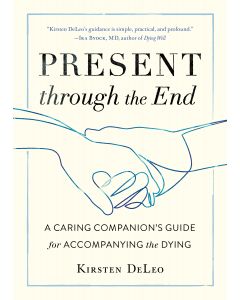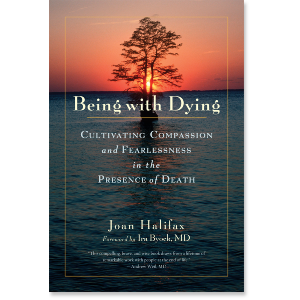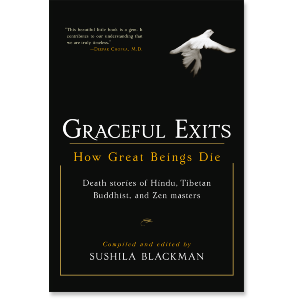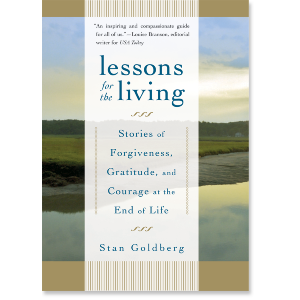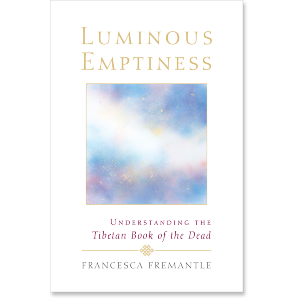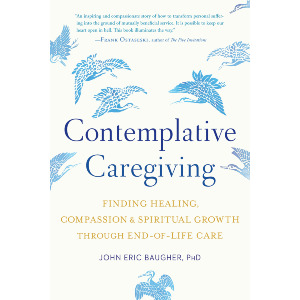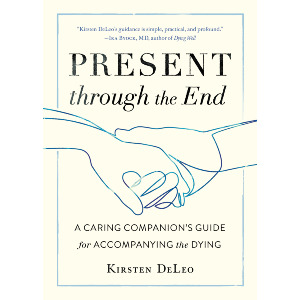

Kirsten DeLeo
Kirsten DeLeo is an international trainer with the Spiritual Care Program, an outreach network that offers education and care in eleven countries. For fourteen years she served as lead faculty of "Authentic Presence," a professional certificate in contemplative end-of-life care that was launched at Naropa University, and now runs as an independent program. She is a member of the Buddhist Ministry Work Group, an initiative of Harvard School of Divinity. Kirsten has been teaching in the field of contemplative care for more than twenty-five years, is a counselor, and has been immersed in Buddhist practice for over twenty years, including a three-year meditation retreat.
Kirsten DeLeo
GUIDES

Excerpt from Present Through the End
“I don’t think I can do this!”
Perhaps this was the first thought that went through your mind when you heard the sad news and you are about to visit for the first time. That’s okay. Most of the time, by simply acknowledging these feelings, they lose their power over us.
It is important, as much as possible, to have an open and clear mind when we are in the presence of a person who is facing death. What we bring into the room—our thoughts and feelings—can have a tremendous impact, positive or negative. If you are anxious, this can become part of the other’s experience. Likewise, if you are at ease, grounded, and open, this atmosphere of confidence will communicate itself. Daijaku Kinst, a friend and Zen Buddhist teacher, poignantly summed it up, “The first step in any care relationship is being less anxious than the person one is serving.”
Knowing we should not bring our anxiety into the presence of dying people is one thing, but actually achieving this can be another. Fortunately, there are ways we can work with our thoughts and feelings that both acknowledge the realities of our challenging experience and also help us find enough inner stability to support someone else.
For one human being to love another: that is perhaps the
most difficult of all our tasks; the ultimate, the last test and
proof, the work for which all other work is but preparation.
—Rainer Maria Rilke, Letters to a Young Poet
Being Spacious with Thoughts and Emotions
Be kind and spacious with the thoughts and emotions that rise in your mind, and don’t judge what comes up. If you have just received the painful news that someone close to you is facing death, for example, all sorts of disturbing thoughts and feelings can surface. This is completely natural, and part of the process of coming to terms with the new reality. Experiences of sadness, anger, fear, confusion, numbness, or grief can come in waves, and often when you least expect them. We can be sitting on the bus, in the middle of a conversation with a colleague, or walking down the street. We can take heart that these are universal experiences—the poem “The Guest House” by Rumi illustrates well how emotions can arise and pass, and how we can be present with them without judgment.
The Guest House
This being human is a guest house.
Every morning a new arrival.
A joy, a depression, a meanness,
some momentary awareness comes
as an unexpected visitor.
Welcome and entertain them all!
Even if they are a crowd of sorrows,
who violently sweep your house
empty of its furniture,
still, treat each guest honorably.
He may be clearing you out
for some new delight.
The dark thought, the shame, the malice.
meet them at the door laughing
and invite them in.
Be grateful for whatever comes,
because each has been sent
as a guide from beyond.
—Rumi, The Essential Rumi, translation by Coleman Barks
It can really help to consider whatever myriad thoughts or emotions that arise simply as experiences that are passing through our awareness. The main point is not to fixate by identifying with them. These feelings are not who we are; they just come and go. Our capacity to simply be aware is linked to our natural awareness that is always present, but is often hidden behind the constant flow of things that pass through our busy mind. We can compare the nature of mind to the sky, the thoughts and emotions to the clouds that move through it. I love Pema Chödrön’s no-nonsense reminder, “You are the sky. Everything else—it’s just the weather.” By connecting with our ever-present but often-hidden natural awareness, we connect with a greater sense of stability and calmness. We tap into our innermost essence or deeper space within our being—clear, compassionate, and open—from which we can hold a healing space for another. This takes practice, but it is possible.
Quietly sitting, body still, speech silent, mind at ease and at peace, you simply let thoughts and emotions, whatever arises, come and go, without clinging to them.
—The Tibetan Book of Living and Dying
Without a center, without an edge . . . without an inside, without an outside . . . as far as the sky pervades, so does awareness.
—Shabkar, The Life of Shabkar: The Autobiography of a Tibetan Yogin
You can try the following practice whenever you feel overcome by difficult thoughts or emotions. You can do it right in the moment you begin to feel overwhelmed, whether you are alone or in the presence of the dying person. This practice is about just being present with and noticing how things are for us—learning to observe thoughts, feelings, and perceptions as they are. We cannot force our minds into peacefulness, however hard we try. By simply being aware and noticing, by giving space and being self-aware instead of reacting, we can learn to manage difficult mental and emotional states. We can try being a neutral observer of what’s happening in our minds. As an observer it may become easier to dissolve or drop difficult feelings or thoughts, or at least to lower their noise level so we can act with greater clarity, genuine care, and kindness.
Sometimes, it can be easier to settle into a calmer place within ourselves when we are alone. If you find yourself in a situation with other people around and you realize things are just too much and you need time alone, be kind to yourself. Don’t hesitate to excuse yourself for a few moments. Do this short practice until you feel more settled and are ready to engage again.
Finding a Place of Calm
When you notice a wave of sadness, fear, negativity, or anxiety rising, pause for a moment, sit down, and just watch what is happening like a neutral observer. Feel yourself centered in your body—notice the feeling of your feet on the floor, the air on your skin—and stay with the natural flow of your breath. In and out. In and out. And again, in and out. Allow the experience to wash over you like a wave, and keep breathing deeply. Like waves, these feelings rise and they subside again. Try to neither follow your thoughts or emotions nor indulge them. Simply be aware. Observe and be mindful of your experience, without evaluating what is happening as good or bad.
If your thoughts and emotions are particularly strong, imagine yourself like the ocean looking at its own waves. Your awareness is as vast as the ocean. There is the natural movement of the ocean’s waves, and at the same time underneath the waves, there is a deep stillness. Or you can imagine yourself like the sky gazing down on the clouds that pass across it. Imagine being as expansive and open as the sky, and allow the cloud-like thoughts to come and go.
Choose the image that resonates with you the most and stay with it for a while. Notice the atmosphere it evokes in your mind, your body, and your heart, and remain mindful, open, and aware. Try to remain in this atmosphere for a few moments longer.
Connecting With Your Good Heart
Before you visit the dying person, always inspire yourself first by connecting with your compassionate motivation, your good heart. This only takes a few seconds, but it makes a world of difference. Our intentions are reflected in the way we care, in our verbal and our nonverbal communication, in the way we touch or gaze at the person. That is why it is so important to clarify our intention and establish our motivation as we start each day, and with each interaction.
Before entering the room, take a moment to check if you are going in with any hidden hopes and fears—expectations, agendas, or worries. Inevitably, without mindful awareness these hopes and fears—however subtle—can be a barrier to making a genuine connection with the dying person. By examining our intentions, we might, for example, realize that we are going to someone’s bedside out of a sense of duty or obligation, rather than our genuine wish. Or, we might find that we want to push our agenda. We should treat whatever we find not as a stick to beat ourselves with but as a valuable discovery. When you find that your frame of mind is not as open or positive as it could be, instead of becoming self-critical, simply use it as a chance to adjust your mental attitude to one that is more beneficial. Quietly holding an intention that we will do our best can do the trick. Even if we don’t quite feel we are in a good place yet, as long as we hold this kind of clear intention in mind and keep working on cultivating a compassionate motivation, it is fine to proceed.
Everything depends on your intention.
All the time, therefore, check your attitude and
motivation.
—Dilgo Khyentse Rinpoche, The Heart of Compassion
Real care of the sick does not begin with costly procedures, but with the simple gift of affection and love. In the practice of healing, a kind heart is as valuable as medical training, because it is the source of happiness for both oneself and others. People respond to kindness even when medicine is ineffective, and in turn cultivating a kind heart is a cause of our own good health.
—The Dalai Lama, foreword to Healing Images
When we connect with compassionate motivation, we connect with our greatest inner resource: our basic goodness. The more we can come in touch with our basic goodness and rest in it, the more courage and natural confidence we will have to relate to the dying person with honesty and without fear. Our presence and love then has the power to offer genuine comfort and reassurance. When we allow these qualities to shine through, it creates a safe environment in which the dying person can relax and rest. Our strength and calmness, our warmhearted attention, can awaken that person’s own inner strength. The following practice can help you check in with your intention.
Setting Your Intention
Before you visit, pause for a moment and become mindful of your intentions. Are there any hidden hopes and fears? Are there any expectations, agendas, or worries that could get in the way? Simply recognize them, and let them go, without judging yourself. Then take a moment to connect with your compassionate motivation, your good heart, and consciously establish your motivation for what you are about to do. You can use a phrase like this: May what I do or say be of benefit and help to relieve suffering.
Whenever you feel you are getting worried about what you can do or say, shift your thinking from the question of “What can I do?” to “What do you need?” This internal shift in perspective from “I” to “you,” from your needs to the other’s needs, will bring you right back to your compassionate motivation.
Getting in Touch With Your Capacity to Care
Perhaps the idea of feeling connected to your good heart, your capacity to care, and your basic goodness sounds too abstract, unattainable, or even sentimental. Whatever we choose to call it, this compassionate motivation certainly does not always come easily, and the connection seems to flicker on and off. We can have a hard time recognizing and appreciating our own ability and capacity for love and compassion. At the start, even if it feels strange or contrived to intentionally connect with your compassionate motivation—your good heart—still, give it a try. It is only a thought, that’s true, but this thought has the power to change our attitude; and, by changing our attitude, the way we perceive a situation and other people will change as well.
Compassion means letting go of your self-identity, letting go of proving that identity all the time. Compassion means you work in the way the wind works, the sun works, or the air works. Take, for example, how the air assumes the shape of the room. The air does not say, “I will give you this breathing space provided you breathe the way I want.” Everyone enjoys the benefit of being able to breathe in the air. It is the same way with the sun: the sun does not stop shining when there are clouds in the sky.
In that same way, selflessness free from attachment, or compassion used with wisdom, means that one goes beyond the way you want to do things. If you can let go of making yourself the most important person in the world, there will be more capacity and spaciousness within you to work with others. You will find more space, time and energy within yourself.
—Khandro Rinpoche, Lion’s Roar
It might not always feel like we care, but our willingness to be present with dying people, no matter what, shows that we do. In times when I feel hard-hearted, closed off, resentful, cynical, self-critical, or discouraged, the following exercise has always helped me to soften these attitudes and reach back into a feeling of caring.
Recalling Your Goodness
Bring to mind a situation when you felt you were able to be present for another person, a moment when your heart went out to a fellow human being who was struggling and having a hard time. This memory does not have to be anything heroic or grand. It can be a small gesture of human kindness or attention, an understanding and feeling of warmth that you showed to someone who needed it. Bring this situation vividly to mind, and remember how you felt at the time. Allow these feelings of warmth, generosity, and connection to soften and dissolve any hard-heartedness, and stay with that memory for a while longer. Let these feelings in. No matter who we are, we all have the capacity to love and care for each other.
Share


Present through the End | Discussion Guide
Guiding Questions
Introduction
Inspired by decades of experience caring for the dying and years teaching contemplative care around the world, Kirsten DeLeo shares down-to-earth advice and offers short, simple, on-the-spot tools to help you handle your emotions, deal with difficult relationships, talk about spiritual matters, listen fully, and practice self-care.
Present Through the End shows you how to be present even when we feel utterly helpless, express your love when loss is just around the corner, and be fully alive to each moment as time runs out.
We hope the following topics will further support you in being present with a dying loved one, friend, or patient. We hope they will spark much needed conversations among families, friends, and communities about acknowledging needs and caring well for those in your midst who are dying.
Use them in your book club conversation, caregiver support group meeting, death café, or curriculum.
Questions and Topics for Discussion
1. Before reading Present Through the End, how did you view death and dying? How did the book change your attitude and outlook?
2. In the first chapter, the author shares how her grandmother taught her the power of a loving presence. Did you have a role model in your childhood or adult life to guide you? Tell your story.
3. We can respond in so many ways to the sad news that someone close to us is approaching death. What was your response when you learned the news?
4. In chapter 2, “Preparing to Care,” the author shares many on-the-spot tools that can help handle feelings of helplessness, sadness, or disbelief, and shows how to find a place of calm in order to connect with the dying person. How did you engage with the practices? Was there a particular practice that helped you?
5. “When we prepare to care, we should remember that a dying person is still a person.” We can often forget a dying person is still a person, another human being just like us with hopes and dreams, concerns, and fears. DeLeo introduces two methods to help you connect with the person you are caring for and understand their behavior and needs: “Just Another You” and “In the Other Person’s Shoes.” Did these practices shift your perspective? What did you learn about the needs of a dying person?
6. The author shows how being present and listening are essential when accompanying a dying person. What barriers or difficulties did you come up against around being present and listening? Recall a tool that helped you stay present.
7. One of the biggest fears dying people have is that their life has been wasted and they will die empty-handed. In chapter 4, “Supporting Connections,” DeLeo offers suggestions for how we can help the person reconnect with their sense of meaning through showing our genuine appreciation of what they have done in their lives and who they are as a person. How did you support the person in reclaiming their sense of meaning and purpose? What was most helpful? Was there anything that did not work?
8. The book describes denial of death as a coping strategy or a crutch to help the person through this painful time and come to terms with the fact they are dying. What have you observed? How did the advice shared in the book help you communicate with the person?
9. A dying person’s beliefs impact how they understand what is happening to them and why. In chapter 4, “Supporting Connections,” the author offers tools to help you explore questions around spirituality (secular and religious), belief, and faith with the person. How did they help you to approach the subject? What gave the person a sense of inner peace?
10. In the same chapter, the author offers questions to help us make a genuine connection. Did you try any of them out? Which of them did you find most helpful, and why?
11. From chapter 5: “In our society, we value autonomy, freedom, and productivity. Experiences of illness and death poignantly show us how temporary and, on a deeper level, how illusory these values are.” Do you or do you not agree with this statement and why?
12. In chapter 5, in the “Considerations for Advance Health-Care Directives” section, the author offers suggestions for exploring the dying person’s wishes and values. How is this information helping you in your preparation for dying? How did it support you in talking with a loved one? Do you have an Advanced Directive or Living Will?
13. Unfinished business and forgiveness can weigh heavily on dying people’s minds, but also on the minds of the people around them. In chapter 5, the author tells the stories of Joe, a veteran, and his son, and of the elderly woman and her fifteen-year-old daughter—two stories with two seemingly different outcomes. If the dying person had regrets or unfinished business, how did the tools offered in the book help you be there for the person and their journey towards embracing forgiveness and finding a resolution?
14. The author shares many stories about being present with dying. Which of the stories do you remember the most and why? What did the book help you discover about life and death, and living and dying?
15. In the book, DeLeo shares sage advice from Buddhist teachers and other contemplative thinkers and poets. What is your favorite poem or words of wisdom in the book? Why does this particular one speak to you?
16. From chapter 5: “Death does not only touch the person who is ill. It touches everyone around that person.” How did you work with family members and friends around supporting the dying person? What was challenging and what was supportive? What advice or tools helped you be present with grieving family members, or navigate family dynamics?
17. From chapter 5: “The best advice for speaking to a child when someone is dying—a beloved grandparent, for example—is to be sensitive but tell the truth. We may think that by not talking about it, we are protecting the child from what’s happening. This is not the case. The child will pick up that something is wrong, not understanding why they get shooed out of the room, or why we cry.” What did you learn about supporting children or young adults? Was there a particular piece of advice Kirsten shared that worked for your situation?
18. From chapter 6: “Taking care of ourselves is not a luxury. It is not selfish. It’s a must.” What are the warning signs that you need to take a break? What nurtures and recharges you?
19. Referring to studies and research, the author explains the differing natures of empathy and compassion. Did this understanding help you recognize where you tend to get stuck?
20. Do you have a regular meditation practice or routine that nurtures your sense of wholeness and wellbeing? How can you make meditation part of your daily life? Which of the methods are you most drawn to?
21. From chapter 6: “Grief does not only start when the dying person is gone. It begins with the terminal diagnosis. We grieve for the life that we knew and the loss of the future that will never be. We begin to imagine what life will be like without our loved one.” DeLeo describes the signs of “anticipatory grief.” How did you deal with feelings of grief? How did the advice and practices like “Being A Friend to Yourself” help you create space?
22. From chapter 6: “Dying can be messy. Every so often, while trying your absolute best, you may find yourself in an absurdly ridiculous, if not funny situation in which you cannot help but laugh out loud. With humor, our shared human experience of living and dying becomes more bearable.” Has this happened to you? Tell your story.
23. From chapter 6: “As caregivers, friends, and family, we also have our work to do. We need to forgive ourselves, and we may also need to work towards forgiveness for the person we are caring for.” Was there a practice, story, or piece of advice shared in chapter 6 that encouraged you to be more self-forgiving and helped you in the process of forgiving another person?
24. In chapter 7, “When Death Approaches,” DeLeo describes how powerful and profound moments of being with dying can break open our protective shell that separates us from others and how these moments can offer us a glimpse of the power of our compassionate heart.Take time to reflect on your own experiences.
25. In the same chapter, the author introduces the practice of Tonglen as a method to unblock our compassion. How did you engage in the practice?
26. Saying goodbye to a dying person is one of the hardest things to do. From chapter 7: “Some people may feel that letting go is a betrayal and a sign that they do not love the dying person enough. Invite family members to imagine they are in the place of the one who is dying and have no choice about leaving. How would they want people they love to be saying goodbye to them? What would help them most on their journey?” Take time to reflect on these questions. What was your process of saying goodbye? How did the advice in the book support you?
27. How did the guide help you communicate and clarify with medical staff and/or family members the wishes for both the moment of death and after death had occurred? Tell your story.
28. From chapter 7: “In the days, weeks, and months that follow the death, be kind to yourself. Grief needs time to heal and much caring attention.” What helped you to be with your feelings of sadness and grief?
29. From chapter 8: “The process of dying is more than medical events. Being with someone during their final weeks and days is an invitation to enter a sacred space and to bear witness to life’s greatest mystery.” How did you create a peaceful or sacred environment for the dying person? Are there traditions or rituals within your family or religion that you followed? Did you encounter any barriers in trying to create a peaceful environment? If so, describe how you worked with them.
30. In the section, “Signs That Death Draws Near,” Ann, a palliative care doctor, and Beate, a social worker, discuss the common signs and symptoms of approaching death. Being at the deathbed, what signs and symptoms did you observe? How were they addressed, or not?
31. In the final chapter of her book, the author tells the reader about the gifts of accompanying a dying person. How did you relate to what she described? Can you recall a gift you have received accompanying a dying person? What are you grateful for right now?
Share


